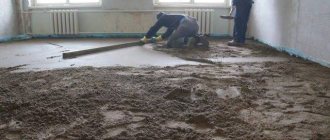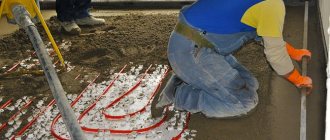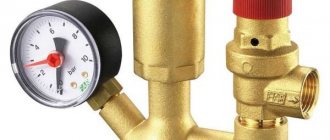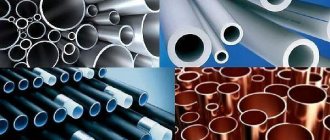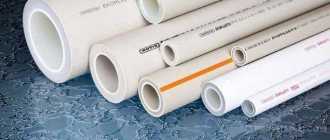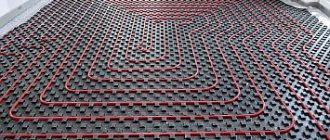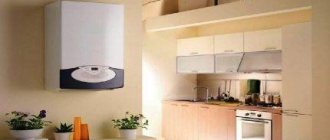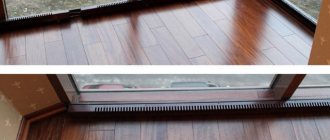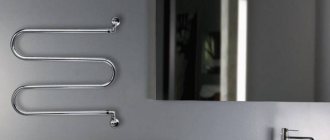Which rehau pipes are best for heating and water supply? Rehau: PINK, FLEX, STABIL, HIS, RAUTHERM main differences and purpose of each.
The article will be extremely useful for those who already want to install pipes from a famous company, but have not fully understood what kind of animal it is and why there is a difference in prices.
I first encountered cross-linked polyethylene pipes in 2010, when the question arose of remodeling the heating system from the developer in my new building apartment. The heating had to be installed in a screed on the floor and soldering the PP was very scary. When I made my choice, and it fell on cross-linked polyethylene, my surprise knew no bounds at the range of prices. And I was tormented by the question of which pipe to buy “purely for heating - pink” or the most expensive one - stabil.
There are several types of pipes, but sellers cannot clearly answer which one is better and for what purpose (perhaps something has changed now, but then...). Conversation from the series, take STABIL, it is of better quality (i.e. more expensive) - why, why, I don’t understand)))).
First, I’ll tell you about the purpose of each pipe and why in one case it is better to use Pink for heating, in another Flex, and in a third you can’t do without STABIL. Too lazy to read, CONCLUSION briefly here - what kind of pipe is used and what is it used for. I hope I will be useful!
Characteristics and types of pipes
Pipes made of cross-linked polyethylene are divided into four groups according to the type of production:
- PEX-a - peroxide;
- PEX-b - silane;
- PEX-c - treated with fast electrons;
- PEX-d - nitrogen.
They are produced with diameters from 10 to 110 mm, operating pressure from 8 to 25 bar. They are designed to operate in a temperature range from 0 to 95 °C and do not react with acids and alkalis.
They are used in devices:
- warm floors;
- heating of domestic and industrial premises;
- cold or hot water supply;
- air conditioner piping.
They withstand freezing of the coolant without breaking connections, and quickly restore their previous dimensions after defrosting the water.
RAUTITAN pink
These are specially designed PEX-a pipes for creating heating systems in private homes and industrial premises. To protect against dissolved oxygen in water, an intermediate layer of ethylene vinyl alcohol is used.
RAUTITAN pink is used in pipelines with a working pressure of no more than 9 bar and a maximum temperature of up to 95 °C. For a short time, polyethylene pipelines will withstand an increase in coolant temperature up to 110 °C. Pipes with nominal bore diameters from 16 to 63 mm are produced, supplied in coils or individual six-meter pieces.
RAUTITAN his
Rehau Rautitan His 311
Rehau RAUTITAN cross-linked polyethylene pipe is used to supply hot or cold water to residential and industrial premises, and for piping process pipelines. It is produced from cross-linked polyethylene of the RAU-PE-Xa brand with the addition of peroxides under pressure. Produced with a nominal bore from 16 to 63 mm in coils or individual pieces up to 6 meters long and with wall thicknesses from 2.2 to 8.6 mm.
The use of this brand of polyethylene ensures stable operation of pipelines at an operating coolant temperature of up to 90˚C. It has a small thermal elongation of 0.15, has flexibility (bending radius is equal to 8 diameters), wear resistance, and a service life of more than 50 years.
RAUTITAN stabil
These pipes are used in heating and water supply systems. RAUTITAN stabil is a multi-purpose pipe with several layers. Between the inner and outer shells there is an intermediate protective aluminum layer. It plays the role of an insulator of the outer layer of non-crosslinked polyethylene from the diffusion of oxygen into it from water.
In water supply systems for drinking water, the pipelines must be designed for an operating pressure of up to 10 bar. In heating systems, RAUTITAN stabil pipelines are installed on lines with an operating pressure of up to 10 bar and a coolant temperature of up to 95˚C.
During emergency situations, it can withstand a short increase in water temperature up to 100 degrees Celsius.
RAUTITAN flex
Rehau Rautitan flex
RAUTITAN flex pipes supply hot and cold water, install heated floors, and use cast iron radiators or bimetallic radiators in rooms for heating.
The intermediate protective aluminum layer not only prevents the penetration of oxygen from water into the inner layers of cross-linked polyethylene, but also promotes better heat transfer. Therefore, these pipes are recommended for use when installing heated floors under: ceramic tiles, laminate, porcelain stoneware.
RAUTHERM S
RAUTHERM S pipe is used for installing heated floors. Due to its low price, a cross-linked polyethylene pipe with a diameter of 17×2.0 mm has become most popular among consumers.
The pipeline is protected from the penetration of dissolved oxygen from the intermediate layer of ethylene vinyl alcohol copolymer. Thanks to the three-dimensional internal structure, products made from cross-linked polyethylene are tear-resistant and do not form cracks throughout the entire period of operation.
The guarantee for the use of pipelines without breaking connections from exceeding the operating pressure by no more than seven times is 10 years.
In cross-linked polyethylene pipes, antifreeze or ethylene glycol can be used instead of water. The flexibility of the pipelines allows the use of various laying schemes in one piece, which eliminates coolant leaks by 100%.
Pipe fittings from Rehau
What kind of briquettes are there for furnace
Rehau fittings are guaranteed to connect parts of pipelines, maintaining complete tightness. The method of pressing pipes and fittings with sliding sleeves forms a non-separable unit during the warranty period. The main feature of non-separable connections:
- they do not have rubber gaskets or O-rings;
- they do not require hydraulic pressure tests to determine possible leaks;
- the internal cross-section is the same along the entire length, there are no narrowings or burrs from the material;
- fittings in drinking water pipes are made of bronze or brass;
- installation of connections is carried out using branded tools, eliminating the possibility of defects;
Attention: technical specifications prohibit the use of brass fittings RAUTITAN MX together with stainless steel RAUTITAN SX. . The diameters of fittings and sleeves for hot water supply and water supply systems range from 16-63 mm
The diameters of fittings and sliding sleeves for hot water supply and water supply systems range from 16-63 mm.
What are the dangers of unprofessional installation?
Installation of Rehau pipes in an apartment, which is carried out by non-specialists and without the use of professional equipment, can lead to the most disastrous consequences. If pipes burst, flooding of the living space and all areas adjacent to it is ensured.
If the gust occurs on the heating system, then in winter you are faced with complete defrosting of the system and the difficulty of restoring it. If you order the Rehau pipeline installation service in, then you will not encounter any of the unpleasant consequences.
The work performed by professionals has several distinctive characteristics:
the pipeline laying scheme is the most optimal and does not interfere with other systems and normal life processes for the owners of residential premises;
each pipeline connection is of high quality and has smooth seams;
for installation, the correct type of pipes has been selected, which is compatible in parameters with the system being installed;
Classification
What types of radiator screens are there?
What does Rehau offer today? The scope of application of the pipes it produces is quite wide. In construction, these are heating systems, plumbing, hot water supply and sewerage.
Sewerage
They are made from polypropylene. Brand – RAU-PP1221. Among the technical characteristics, it is necessary to note the long service life; the products can withstand heavy loads and temperatures. Let's add ease of installation here.
The elements are connected using fittings and shaped products. The company offers sewer pipes that can be used for both internal and external networks.
Cold and hot water supply
For these systems, the company produces products made from cross-linked polyethylene.
This variety is gradually replacing metal-plastic analogues due to its high technical and operational characteristics and ease of installation.
Heating
This life support system uses two types:
- Metal-plastic.
- Made from cross-linked polyethylene.
Gradually, pipes from the second group are replacing the first type. This is due to new requirements for heating systems, where the water temperature sometimes reaches +100 °C. Metal-plastic products can only withstand +95 °C.
history of the company
The Rehau company began its history in 1948 in the city of Rehau, Bavaria. The small production produced shoe soles, hoses and some parts for cars. Three years later, another small plant was opened in another city, Voithwagen, which began producing pipe products. By the way, this plant, already re-equipped, is today the main production capacity of the company.
In those years, the main focus was the production of bumpers, hoses and small diameter pipes for Volkswagen cars. In 1958, a new method was used - extrusion. Its final product was a PVC profile. Ten years later, the company began producing cross-linked polyethylene pipes, which are still used in building heating systems.
Twenty years later, the company's engineers proposed a completely new approach to connecting pipes using a sliding sleeve. This was, in fact, a breakthrough, with the help of which it became possible to increase the safety of the operation of cars and heating networks, among other things.
The Rehau company entered Russia in 1995, opening its representative office. In 2002, a small workshop was opened in Ramenskoye (this is the Moscow region). And already in 2005, a full-fledged plant was opened in Gzhel, which produces rehau pipes for various purposes.
Advantages and disadvantages
How to choose a water heater, what types of water heaters are there, features of each type
Just like any product has its advantages and disadvantages, Rehau products also have them.
Advantages:
- easy and quick to install;
- do not transmit noise from moving water to monolithic house structures;
- long service life - 50 years;
- versatility;
- do not corrode;
- do not form a coating of calcium and iron salts on the inner surface;
Thanks to the wide variety of fittings, you can easily fit into the water supply or heating system.
Flaws:
- relatively high cost;
- expensive installation equipment;
- require the installation of “P” or “G” shaped temperature compensators on long sections of pipelines;
- the flexibility of polyethylene requires auxiliary fixing elements.
Rehau-PEX pipes, despite their high cost, are confidently conquering the market, squeezing out competitors.
Advantages of the RAUPIANO Plus sewer system from Rehau
RAUPIANO Plus is a system of polymer multilayer sewer pipes and accessories for them.
One cannot speak in general terms about the pipes of the RAUPIANO Plus system. They are radically different from everything that other companies produce. The list of advantages of such pipes is simply amazing:
1) Noise absorption.
It is this advantage that the manufacturer himself always puts to the fore. Rehau sewer pipes muffle extraneous sounds by 30% better. For polymer pipes this is a real achievement. Only cast iron structures have a similar level of sound insulation, but they are already outdated for a number of reasons.
2) Multilayer construction.
There are three layers in total:
- The external one serves to protect the pipe from various harmful factors; it is resistant to shock and environmental influences.
- The second layer is reinforced with mineral compounds. They participate in the sound absorption process and also increase the strength of the pipe.
- The last layer is inside the pipe. It is particularly resistant to corrosion and prevents the accumulation of deposits.
3) Versatility.
RAUPIANO Plus is suitable for all areas of the sewer system. Pipes and components perform equally well in both external and internal sewer systems. Due to their high stability, the pipes can be used even in a pressure system where the pressure is constantly changing.
4) Freedom of planning.
In addition to the fact that such pipes are suitable for use in all areas of the sewer system, they can also be laid in both brick and concrete walls, under suspended ceilings and facing materials.
5) Large selection of additional elements.
In addition to the pipes themselves, the system includes a large list of fittings and fasteners. All of them are made using the same technology as the main products, which means they can withstand no less loads. However, the manufacture of additional elements has its own peculiarity and this is another advantage of such a system.
6) Thickening in the area of bends.
Fittings of other systems are the weak link of the entire sewer system. Typically, it is in these areas that various breakdowns, leaks and a lot of wear occur. Rehau sewer pipes have successfully solved this problem. In the areas of bends, turns and branches, the system has thicker walls, which significantly increases stability.
7) Beautiful design.
As a standard, polymer pipes for internal sewerage have a gray body tint, and for external sewerage - orange. All elements of the RAUPIANO Plus system are white, which most closely matches modern plumbing fixtures. When installing in a toilet or bathroom, many people don’t even have to make structures that hide the pipes, because they fit perfectly into the overall look.
Easy installation.
RAUPIANO Plus pipes are connected using a socket system. Each socket has an O-ring made using unique Rehau technology. It protects the seams between pipes from leaking and simplifies installation. No additional materials or devices are required to connect the pipes to each other.
9) Fire safety.
You can purchase firefighting cuffs separately for the pipes. They are installed on the ceiling and against the walls, and are blocked at temperatures above +120°C. This prevents fire and smoke from spreading between floors through the sewer system.
Advantages and disadvantages
Rehau Rautitan products are made from high quality polymer compounds using the most modern technologies, which ensures their amazing performance.
Rehau pipes have undeniable advantages.
- Unique connection system. Sliding sleeves allow for high-quality installation even by people without special skills, while the chance of incorrect joining is about 2%. It also provides the following: installation of the pipeline without welding, soldering or other special means;
- high reliability and tightness of the joint, so pipes can be sewn into walls without fear of leaks;
- minimum terms of work.
- Excellent elasticity and flexibility, no kinks.
- High resistance to abrasive materials, mechanical shock, vibration.
- The polymer perfectly absorbs noise.
- Pipes do not corrode, do not shrink, or rot.
- The polymer is completely resistant to the freeze-thaw cycle.
- Pipes are made from inert substances that are not harmful to health.
- Excellent memory of material. After bending, the pipe regains its shape. When stretched, shape restoration occurs if the elongation does not exceed 300%.
- The service life depends on the conditions and ranges from 5 years (under the most severe conditions) to 50 years (under normal conditions).
In addition to positive qualities, Rehau products have their weaknesses, such as:
- water pipes are very strong and elastic; tools will be needed to bend products with a diameter of more than 32 mm;
- push-on fittings are not cheap, and as the diameter of the pipe increases, their price increases;
- The pipe material is vulnerable to direct sunlight.
The approximate cost of pipes depends on the type, namely:
- Rehau Rautitan Stabil with a diameter of 16–32 mm costs approximately 110–375 rubles per 1 m;
- Rehau Rautitan Flex with a diameter of 32 mm will cost 305–310 rubles per 1 m, and with a diameter of 50 mm – 620 rubles;
- the price for 1 meter of Rehau Rautitan His with a diameter of 16 mm will be approximately 115 rubles, with a diameter of 32 mm - 445 rubles, and the widest version of 63 mm - about 1170 rubles.
Differences between Rehau pipes and similar products
Pipelines of this brand are made of high quality polyethylene, which is much better than polypropylene.
Advantages inherent in Rehau pipelines:
- resistance to corrosion processes;
- low degree of thermal conductivity;
- The temperature of the working environment can reach 95 degrees. At the same time, PP pipes are not able to withstand a wide temperature range without loss of quality;
- have shape memory, which ensures complete tightness of the connection;
- excellent sound insulation;
- resistance to various mechanical and chemical influences;
- resistance to UV radiation;
- long service life - up to 50 years.
By comparison, polypropylene products are susceptible to ultraviolet radiation and exhibit significant thermal expansion. Rehau pipe products are an excellent combination of price, quality, reliability and functionality, and in many ways surpass the products of other companies on the market.
Prices
The cost of Rehau products depends on the series of channels and their sizes.
To see the average price per meter of these products, see the table below.
| Pipe type | vendor code | Packing size | Price (€) |
| 2.2x16 mm | 136042-120 | 120 m | 2,12 |
| 2.2x16 mm | 136042-006 | 60 m (6 m each) | 2,42 |
| 2.8x20 mm | 136052-120 | 120 m | 2,76 |
| 2.8x20 mm | 136052-006 | 60 m (6 m each) | 2,97 |
| 3.5x25 mm | 136062-050 | 50 m | 4,13 |
| 3.5x25 mm | 136062-006 | 30 m (6 m each) | 4,47 |
| 4.4x32 mm | 136072-050 | 50 m | 5,74 |
| 4.4x32 mm | 136072-006 | 30 m (6 m each) | 6,21 |
| 5.5x40 mm | 136082-006 | 12 m (6 m each) | 9,64 |
| 6.9x50 mm | 136092-006 | 6 m | 12,63 |
| 8.7x63 mm | 136102-006 | 6 m | 18,25 |
You can find out more about the prices for the products in question on the websites of the company’s official dealers. There you will find comprehensive information on this issue. We strongly do not recommend purchasing products from resellers or companies with a dubious reputation. There are quite a lot of fakes sold on the market. Therefore, you should not take risks to save money. It’s better to buy quality materials once than to spend money, time and energy on correcting mistakes later.
The cost of installing Rehau pipes depends on the scale of the project. For a small one-room apartment, this figure in Moscow and St. Petersburg can be from five thousand rubles. In Kyiv, these works will be cheaper. The minimum cost of installing Rehau pipes in the Ukrainian capital can be about one thousand hryvnia.
Below you can watch a video in which you will learn a lot of interesting information regarding the products of the German concern Rehau.
Tips for choosing
To have an idea of what components to buy, before going to the store you need to make a drawing of the network, indicating the necessary fittings with dimensions. The main thing is to know the diameter of the pipes and receiving devices and their material.
Choosing elements from the lower price category is not always justified. The longevity of the entire network depends on the quality of the connecting parts, which are more expensive than dubious counterfeits.
It is necessary to select components:
- Taking into account hydraulic and temperature conditions.
- In specialized stores, which will protect you from purchasing counterfeits and defective parts.
The best manufacturers
Preference should be given to products from well-known manufacturers who provide guarantees for their products:
- The German companies Oventrop, Wefatherm, and Aquatherm are confident leaders in the domestic market of polypropylene products. Czech and Ekoplastik are slightly inferior to them. They all provide a 15-year warranty on their products.
- Italian products are in wide demand.
- Further, experts and professional installers give preference to Turkish ones, “TEBO”, “Pilsa”, “FIRAT” mainly for their affordable prices. Manufacturers from Turkey provide a 10-year warranty.
Recently, products from Russian manufacturers have also successfully proven themselves. produces products with an EAN 13 certificate. The Egoplast enterprise near Moscow produces ProAqua polypropylene elbows.
The products of the group, a Russian manufacturer of plastic pipe products, receive a lot of positive feedback.
approximate price
Prices for fittings depend on their sizes and manufacturer.
Thus, an equilateral coupling press 20×20 Comtek produced by Compipe costs 225 rubles. The same coupling from VALTEC will cost the buyer 193 rubles.
Types of Rehau fittings
Conventionally, all connections can be divided into three groups: couplings, tees and elbows. Distribution combs and manifolds can be included in a separate category.
Based on the type of installation, there are three main methods:
- compressor;
- compression;
- welded
The Rehau company produces fittings of all types.
Compression (adjustable)
The compression type of installation is also called serviceable, since such a fitting can be dismantled at any time without damaging the parts. This may be necessary, for example, to replace seals.
This fitting consists of:
- couplings;
- collet ring;
- crimp nut;
- seals;
- gaskets
A ring and nut are put on the pipe. The coupling fitting has two o-rings and a gasket. The coupling is then inserted into the pipe and crimped. The coupling has both special ribs to hold the seals and threads to connect to the nut.
The advantages of such a fitting include the fact that for its installation you only need two adjustable wrenches; wrenches can also be used.
Crimping
This fitting consists of only two elements - a coupling and a ferrule. For installation, you will need special equipment - an expander and a tool for axial pressing. The sleeve is placed on the pipe with a chamfer towards the connection. The pipe itself is expanded by an expander to a size that allows the coupling fitting to be inserted into it. The sleeve is then pushed under pressure over the area where the fitting is located. Dismantling of such a fitting is impossible. You will have to cut the sleeve, which is quite difficult. This fitting is mounted very quickly and reliably.
Welded
As an alternative, the electrodiffusion welding method is used, but it is unlikely to be possible to implement it yourself. Firstly, even the company’s instructions do not clearly describe this connection method and specifically stipulate that such work can only be carried out by specialists. Secondly, for this method of fastening you will need quite specific equipment, which is problematic to obtain. In addition, the price of such an instrument is quite high.
According to the technology, the coupling is put on top of the connection. Inside the coupling there is a wire that acts as a heating coil to which current is supplied. The surfaces to be welded are heated to the melting point and subsequent connection occurs.
Cross-linked polyethylene
What it is
Cross-linked polyethylene Rehau Rautherm can only be red.
Polyethylene pipes have been used for a long time. Products made from this polymer have proven themselves excellent as pipes for cold water supply and drainage, as well as for transporting other substances that do not cause chemical destruction of polyethylene. However, this option is not suitable for hot water, as it has low heat resistance.
Pipes made of ordinary dense polyethylene are most often used for water supply.
Given the excellent characteristics of polyethylene pipes, scientists decided to modify this polymer so that it could withstand the loads inherent in hot water supply systems.
Molecularly cross-linked polyethylene: bonds between molecules.
Soon a solution was found: the developers of the new plastic saw that the strands of molecules could be stitched together, forming spatial bonds between carbon atoms. Moreover, four different crosslinking methods have been found:
- Peroxide. The material is designated PE-Xa. The most expensive and most effective stitching method. By adding hydrogen peroxide to the high-density polyethylene melt, the highest possible degree of cross-linking of the material at the moment is achieved - 75%.
Rehau cross-linked polyethylene PE-Xa pipe.
- Silane. The result is a polymer designated PE-Xb. The polyethylene melt is treated with moisture containing organosilanide and a special chemical catalyst. As a result, cross-linking with a degree of 65% is achieved and the price of the material is reduced.
Silane cross-linking also gives good results.
- Electronic. The resulting material is designated PE-Xc. The method involves bombarding solid polyethylene with charged electrons. As a result, cross-linking is achieved, the degree of which does not exceed 60%. This is the cheapest method, although the material differs somewhat in quality and features.
Electronic stitching is cheap and quite durable.
- Nitric. The least common method that produces PE-Xd. The reaction of treating polyethylene with nitrogen compounds is technologically quite complex, so it is practically not used today. Gives cross-linking up to 70%.
Cross-linked polyethylene is a polymer whose strands are interconnected in space to form a three-dimensional molecular lattice similar to that created by the atoms of solids. The material is different:
- increased strength;
- heat resistance;
- resistance to corrosion and chemicals.
Differences between Rehau products
Rehau Rautitan pipe of flex and stabil brands.
Rehau is a world leader in the production of cross-linked polyethylene PE-Xa and products made from it. The high popularity is due to the fact that the company has created a full-fledged system, which is distinguished by a fully thought-out and unified installation process - from cutting the pipe to the final installation of the system and putting it into operation.
This is what the assembled heating system looks like.
The water heated floor system is characterized by increased requirements for the quality of the pipeline and connections. To independently understand where you can save money and where you should spend money, you need to have sufficient experience in working with heated floors.
Moreover, you will still spend time and money selecting, searching and purchasing all the necessary fittings, tools, etc.
Connection to fittings of different configurations occurs in the same way.
Rehau company offers a fully thought-out system, including several types of pipes, tools and a complete set of parts. The installation of Rehau pipes is unified and does not depend on the scope of application.
This allows us to characterize the product as the most reliable and suitable for those who are used to getting the expected result instead of playing roulette.
A pipe connection consists of three main elements: pipe, sleeve and fitting.
Features of BIRPEKS products
The advantages of cross-linked polyethylene have been known for several decades, but the rather high cost prevented the material from being widely used in our country. Everything changed with the advent of the Russian manufacturer BIR PECS, which launched the production of good quality products at an affordable price.
Before starting production, BIR PECS conducted research to identify the most optimal material option, which is necessary in the climatic conditions of Russia and the CIS countries. BIR PECS products include several systems for heating, water supply and underfloor heating, namely:
- BIR PEX Optima;
- BIR PEX Standard;
- BIR PEX Standard UV-Stop;
- BIR PEX Light (underfloor heating system).
Beer pex pipes
All products of the BIR PEX company are produced on modern English equipment, which guarantees high quality. The main advantages of the BIR PEKS pipe can be briefly described as follows:
- Increased resistance to cracking;
- Operating temperature up to 90 ˚С;
- Working pressure - 65 atmospheres at 20 ˚С;
- High permissible loads;
- Long term of use.
All BIR PEKS products are equipped with compression, crimp or press-on fittings, which allows installation of communication systems even by people who do not have special tools. The use of BIR PEKS pipe allows you to replace the hidden section of the pipe without dismantling the wall or floor, which is impossible for other types of pipeline.
Installation of heating systems Rehau
The assembly of Rehau metal-plastic and plastic heating systems is carried out in the same way as in the case of using polypropylene products.
There are very few differences, just a few:
- Installation is carried out using the Rautool tool, which is used to connect products with a diameter of 14-110 millimeters. The drive for it can be manual, electric or battery.
- When arranging heating, it is necessary to use special polymer fittings of different diameters.
- The company's own development is the installation of elements with a movable sleeve, thanks to which it is possible to install the pipeline without revisions.
RAUTITAN RAUTHERM
Thin-walled products in this series are available in two versions: RAUTHERM-S (red) and RAUTHERM-SL (yellow), as well as RAUPINK, which has a thick-walled design. The latter option is made of polymer materials and has a protective layer that protects the product from exposure to oxygen. Red pipes are widely used in heating systems. When carrying out repair and restoration work without welding, products that are yellow in color are used. This material can be used for wiring under the baseboard. Their installation is simple and fast due to their high flexibility.
Assembly tool
The Rehau company made sure that the installation of its pipelines occurred as correctly as possible, and it was for this purpose that it released a special tool, RehauRAUTOOL. The simplest basic tool kit Rehau RAUTOOL M1 consists of several tools necessary for installation:
- Pipe cutting shears 40 RAUTITAN Stabil.
- Manual pipe expander Rehau RAUTOOL RO system.
- A set of replaceable nozzles for expanders of different diameters.
- Manual press for crimping sleeves, called "basic tool M1", with a set of attachments for sleeves of various diameters and mounting pins.
- Lubricant in a tube.
- Brush for cleaning tools.
- Suitcase for transportation.
It should be noted that a set of tools is quite expensive, but on any construction market it can be rented for the duration of the work.
Installation process
The installation technology includes several steps.
- We screw a nozzle with the required diameter onto the expander.
- After that, we put crimp rings on the pipes themselves with our own hands. And we do this so that the place where the pipe expands is not occupied.
- An expander must be inserted into the pipe. It expands when the installer presses a special handle. The next step is to rotate the pipe itself or the expander by 30 degrees. And then press the handle again. You can repeat the operation to consolidate the result. After this, proceed to using the fitting.
- The shutter is removed from the press with your own hands. Next, pull out the pins used for fastening. The next step is to thread the nozzles, which are secured with pins. The shutter snaps shut.
- The connection takes on a finished form. The product must be removed from the press.
Pipes made of heat-resistant polyethylene PERT
This is a new modern material, which not everyone knows about in the construction market, especially ordinary buyers. There are Pert pipes of types 1 and 2:
— type 1 pipe is standardized, has temperature limits of up to 70 degrees, so the main purpose is low-temperature heating systems (for example, installation of heated floors); applicable up to operating class 4; pipe diameter and wall 16x2.0, 20x2.0, therefore, compatible with radial crimping systems;
— type 2 pipes are a material that, in terms of its characteristics, is almost close to PEX, or even in some ways ahead of them. There is no memory effect inherent in many PEX materials, but it is still better to refrain from repairing the fracture. Has an oxygen-protective layer.
Rauterm-S pipe products
Rehau pipes for heating of the Rauterm-S brand are a special type of polyethylene product that is used for the installation of heated floors in buildings for various purposes.
Main advantages compared to other types of similar products:
- resistance to corrosion, chemical and abrasive effects, mechanical wear;
- no salt deposits;
- resistance to high temperatures (can be used at temperatures up to 90 degrees).
They produce pipes with a diameter of 17-25 millimeters. They serve for about 50 years. Products for heated floor construction comply with sanitary requirements and European standards.
Types of pipes
According to their purpose, products can be divided into two types: for water supply and heating.
They also separate internal engineering systems and surface heating and cooling systems. The former can be used for both water supply and heating, the latter – only for heating/cooling.
Heat supply systems are placed in a separate category.
The Rehau company also produces polypropylene pipes for internal sewerage.
For internal engineering systems, special pipes RAUTITAN his and RAUTITAN pink are used. The former are intended for cold and hot water supply, the latter are used for heating systems.
All Rehau products are manufactured using the RE-Xa method, that is, the peroxide cross-linking method. The proposed diameter is from 16 to 63 mm.
RAUTITAN stabil can be used as universal pipes, but their maximum diameter is 40 mm, or RAUTITAN flex with a diameter of up to 63 mm.
A new product is insulated pipes of these brands, which have a layer of extruded polyethylene foam insulation. They are intended for thermal insulation of heating systems on load-bearing floors.
Isolation allows:
- enhance the water-repellent effect;
- increase resistance to aging;
- protect from heat generation and condensation;
- protect against sound transmission through building structures.
For surface heating and cooling systems (such systems also include heated floors), RAUTHERM S and RAUTHERM SPEED are offered. The second feature is the presence of adhesive tape on the surface for attachment to mats for installation.
In addition to floor systems, both wall and ceiling systems can be installed. At the same time, ceiling ones are offered in the form of gypsum boards with an already built-in pipe.
RAUVITHERM UNO (with one insulated pipe) and RAUVITHERM DUO (with two) are used as heat supply systems.
Find applications in the following areas:
- centralized and local water supply;
- water supply with drinking and hot water;
- pool equipment;
- refrigeration equipment;
- industry and agriculture;
- air-water pump connections;
- heat pumps that use the heat of the earth.
The noise-absorbing internal sewage system is represented by RAUPIANO PLUS. The diameter of these products is from 40 to 200 mm. These are polymer multilayer pipes with reinforcements in cornering areas. Special clamps are also used to absorb noise. Polypropylene is more expensive than HDPE pipes, but it is lighter, stronger and has a smoother surface, therefore it is more resistant to dirt.
A little about Rehau
The Rehau company was founded in 1948 in the Bavarian city of the same name. In addition to its president Helmut Wagner, the staff initially included three employees who serviced one extruder.
Currently, Rehau is the world's largest concern with an annual turnover of 3.4 billion euros. The company has approximately 20,000 employees who work in 41 enterprises, 105 sales offices, 23 administrative and 9 distribution centers.
Rehau is known as a manufacturer of:
- Polymer components and electrical equipment for automobile concerns Porsche, Volkswagen, BMW and Audi.
- Plastic window and door systems from the Rehau metal-plastic profile, well known to the average consumer.
- Garden hoses, sewer and cross-linked polyethylene pipes for water supply and heating networks, the production of which was mastered in 1968. 20 years later, in 1988, the technology of connecting them using sliding (tension) sleeves was introduced.
- Blinds, furniture and about 15,000 components for its assembly.
- Interior heating and cooling systems, solar panels and components for geothermal heat pumps.
Rice. 2 Molecular lattice of ordinary and cross-linked polyethylenes
Warm floor
Practice shows that the main direction of use of pipes from the Rehau company is the underfloor heating system
It is important to carry out calculations correctly and choose the right installation scheme.
Wiring types
The routing of rehau pipes can be done with a snake or a spiral.
The first option is the simplest, but it has one drawback - the coolant at the end of the circuit is very cool, which leads to uneven heating of the entire floor. Therefore, experts advise using a spiral as a pipe connection.
Calculation
As for quantity, it is necessary to take into account the heat transfer rate in linear form. For example, a pipe with a diameter of 16 mm distributes heat well over a distance of 15 cm on both sides
That is, its total coverage is 30 cm. This means that between the branches of the contour you can install a space of 30-35 cm.
It is not difficult to calculate the number of branches, knowing the size of the room. This figure is multiplied by the length of the room, but it must be taken into account that the distance from the walls to the pipes should be 20 cm.
Device and purpose
Pipe fittings are connecting parts used to fasten pipeline elements, connect a battery to the system, install faucets, liquid drain points, water circulation pumps, and household appliances.
Fittings are used for different purposes:
- stopping the liquid that flows through the pipes;
- connecting additional circuits, branches, highways;
- creating detachable connections;
- connections of pipes made of different materials;
- temperature adjustment for “warm floor” systems;
- installation of mechanisms for adjusting the coolant flow rate.
The main task is to connect individual parts of the pipeline.
Main types and their features
The Rehau company produces pipes designed for use in pipelines for various purposes. It is advisable to choose products that have positive reviews and good technical characteristics. The wiring can be installed with your own hands, if you take into account the recommendations of specialists. All products in the Rautitan line are divided into types, each of which is focused on performing specific tasks: supplying hot and cold water, heating and installing heated floors. Several types of pipes have been created for these purposes.
Stabil
These are functional pipes, which are made on the basis of a metallized polymer and are painted silver. Structurally, they have an aluminum layer, and the inner layer is cross-linked polyethylene (PE-X/AI/PE). They can be used in any type of water supply: cold and hot water, low-temperature heating.
The performance characteristics of Stabil type pipes are as follows:
- operating temperature up to +95ºС, can withstand surges up to +110ºС;
- cross-sectional diameter is 16–63 mm;
- are characterized by elasticity and have high strength indicators;
- working pressure – up to 10 atm.
The pipe is sold equipped with a coupling and sleeve for optimal sealing of joints. In addition, the installation process is simplified and accelerated. The installation does not require a seal; immediately after its completion, you can begin operating the pipeline. If necessary, you can create a pipeline branch; use the rotating elements supplied with the pipe in the kit.
The Stabil series is sold with the following pipe dimensional parameters, where the first value is the outer diameter of the pipe, and the second is the wall thickness:
- 16/2.6 mm;
- 20/2.9 mm;
- 25/3.7 mm;
- 32/4.7 mm;
- 40/6 mm.
At the same time, the length of the manufactured products is 5, 50 and 100 meters, the second and third options can be cut into 10 meters. Its duration varies depending on operating conditions. The following relationship, where the first is the operating temperature in ºС, the second is the operating pressure in bars, and the third is the guaranteed service life in years, shows clear options:
- 20/35/50;
- 70/20/50;
- 95/15/5.
From this it can be seen that operation at maximum temperature conditions significantly reduces service life.
Flex
Flex is a universal type of pipe. Unlike the Stabil type, it can be used in any type of heating, not just low-temperature. The inside of the product is made of stitched polyethylene PEX-Xa, which is coated with ethylene vinyl alcohol, which protects against oxygen. This is the main difference between the Flex and Stabil types. Its task is to protect liquid from air penetration, otherwise the structure of the products is almost identical. Flex pipes are connected using special sleeves.
The Flex series is sold with the following pipe dimensional parameters, where the first value is the outer diameter of the pipe, and the second is the wall thickness:
- 16/2.2 mm;
- 20/2.8 mm;
- 25/3.5 mm;
- 32/4.4 mm;
- 40/5.5 mm;
- 50/6.9 mm;
- 63/8.6 mm.
The lengths are sold in pieces of 6 meters and in coils of 50 and 100 meters with the possibility of cutting into pieces of 10 meters. Operating conditions affect the service life of the pipe. As can be seen in practice, the approximate parameters are as follows, where the first is the temperature of the liquid in the system (degrees), the second is its pressure (bar), and the third is the warranty period under such conditions (years):
- 20/18,2/50;
- 70/10/50;
- 95/9/10.
His
The His line of pipes has a universal purpose; it is made from cross-linked peroxide polyethylene PEX-Xa. The pipes are painted white. They can be used in drinking water, hot and cold water supply systems, as well as in heating systems. His pipes are connected using sliding sleeves, ensuring a strong and airtight connection.
The characteristic features of products of this type are the following:
- operating temperature up to +90ºС;
- long service life;
- minimal thermal expansion;
- good memory of material;
- excellent strength and wear resistance;
- elasticity and flexibility;
- the internal coating prevents deposits;
- simple and quick installation.
Rehau Rautitan His are sold in size variations with an outer diameter of 16–63 mm in 6-meter lengths, in coils of 50–100 meters with a diameter of up to 32 mm.
Rehau pipes insulated
A distinctive feature of Rehau pipe products is the presence of products built into insulation made of extruded foam polyethylene (PE) with the following characteristics:
- Serves to protect the pipeline from cooling by the environment, prevents the accumulation of condensate and is a sound insulator.
- It has an operational service life equivalent to a PEX pipe, that is, at least 50 years.
- Available in round and rectangular shapes.
- The color of the polyethylene insulation is silver according to RAL 9006 (white aluminum).
- The outside of the insulating shell is covered with polyethylene film.
- Thermal conductivity of polyethylene insulation is 0.040 W/(m•°K).
- Used on Rautitan Stabil, Pink and Fiexe pipes with diameters of 16, 20 and 25 mm (round shell), 16 and 20 mm (square section heat insulator).
- The thickness of the protective layer for square insulation is 9 and 26 mm; for round thermal protection, its wall dimensions are 4, 9 and 13 mm.
Also, to protect pipes from condensation, mechanical damage, and compression when laying in a concrete screed, when the pipeline passes an expansion joint, black corrugation is produced. It is made of low-density polyethylene, capable of withstanding temperatures up to + 105 ° C. Corrugated casing is used on pipe products with diameters of 16 (16.2), 20, 25 and 32 mm.
Rice. 7 Dimensional parameters of thermal insulation of Rautitan Stabil pipes
Related article:
Heating pipes - all types of modern pipes, which is better to choose . When thinking about laying heating pipes from Rehau pipes, it may be interesting to find out what other heating pipes there are, what are their differences, methods of laying and installation.
Types of fittings for cross-linked polyethylene
Depending on the operational properties and design features, all fittings for cross-linked polyethylene are divided into groups according to the material from which they are made, by design features and by installation method. When choosing fittings, you must take into account the features of the pipeline system.
Working with a fitting for cross-linked polyethylene
Material used to make such connections:
- polyethylene;
- polypropylene;
- polyvinyl chloride;
- from combined materials.
Manufactured designs of connecting elements:
- couplings - used for a straight section of a pipeline; they can connect pipes of the same diameter or different ones;
- angles - used for corner connections or, if necessary, to change the direction of flow in the pipeline;
- plugs - needed to close the final section of the pipeline if further movement is not intended;
- tees - used to connect three pipes or when it is necessary to branch the main pipeline flow;
- bends - used to connect a new section of pipe to an already installed pipeline.
According to the type of installation, connections for cross-linked polyethylene are divided into:
- for cross-linked polyethylene;
- pressed fittings.
Features of the fitting for cross-linked polyethylene
Compression elements made of cross-linked polyethylene are produced in a collapsible design. Good sealing of the structure is created by a plastic gasket and a union nut.
Press fittings are used where a permanent connection with high tightness is required. They are often used on pipelines operating under high pressure.
Tying radiators with polypropylene pipes
Tying the heating elements is the main stage in installing a heating system. The essence of the process is the installation of special equipment that will regulate the heat transfer process. With its help, the battery is disconnected in case of accidents, replacement of system elements and flushing.
For high-quality installation of the heating system and its efficient operation, you should purchase shut-off valves, fittings, and installation tools.
Shut-off valves
It is necessary to install shut-off valves on polypropylene pipes when entering and exiting the coolant.
Types of shut-off valves when connecting polypropylene pipes to heating radiators:
- Valves (ball valves recommended). Conventional valves are installed on the inlet and outlet pipes directly in front of the batteries. With a single-circuit system, an additional valve will be required for the jumper between the return and supply (to the bypass). Valves are used to shut off the coolant flow if necessary when the system is running. It is impossible to limit the flow of coolant into the radiator using a ball valve - installing it in an intermediate position leads to destruction of the valve.
- Throttles are special valves that regulate the flow of coolant into the radiator. The throttle will allow you to manually limit heat transfer. Up to 2 hours pass between closing the valve and the temperature drop in the room.
- Throttles with thermostats (thermostats). Such devices independently regulate the supply of coolant depending on the specified parameters. These devices allow you to maintain an even air temperature regardless of weather fluctuations.
Polypropylene thermostats for connecting radiators to polypropylene pipes are the best choice, although it can hardly be called budget.
Fitting
To connect a radiator to a polypropylene pipe, to connect distribution pipes to central pipes, the following connecting parts will be required:
- Polypropylene tees with a transition hole. Standard adapters from 32 main pipe diameter to 25 distribution pipe. When switching to a radiator from 25 diameter to 20;
- To install shut-off valves, use a combined triple coupling - two welded polypropylene outlets on a pipe (25 diameter) + a 0.5-inch (20 mm) threaded outlet on a valve;
- To connect the shut-off valves to the radiator, use an American coupling with a union nut and a threaded connection.
We recommend that you read: Differences and areas of application of polyethylene and polypropylene
Tools
To install polypropylene pipes and heating radiators, you will need a standard set of tools:
- Welding machine or soldering iron for polypropylene materials;
- Shaver for removing aluminum reinforcement at the joint (when choosing polypropylene pipes reinforced with aluminum);
- Device for cutting polypropylene pipes;
- A special key with a hook for installing shut-off valves.
Work order:
- installation of radiators;
- installation of shut-off valves;
- cutting, welding of the main pipe with the distribution system;
- installation and installation of additional components (jumpers, compensators);
- connection of pipes and radiators.
When connecting radiators to polypropylene pipes, materials that are resistant to high temperatures should be used as a sealant for threaded connections. As a rule, linen tow with paint or a special synthetic thread is used for this.
Method for producing cross-linked polyethylene
Rehau cross-linked polyethylene is produced in two ways: using chemical reactions and hard radiation. The chemical method uses low-density polyethylene plus foaming catalysts, stabilizers and other chemical additives. After mixing in an extruder under high pressure and temperature, polyethylene molecules break and crosslink.
Irradiation of polyethylene with fast electrons leads to modification of the internal molecular structure. During irradiation, the chemical formula of the substance remains unchanged, but cross-links are formed between neighboring molecules. The result is increased tensile strength compared to conventional polyethylene.
